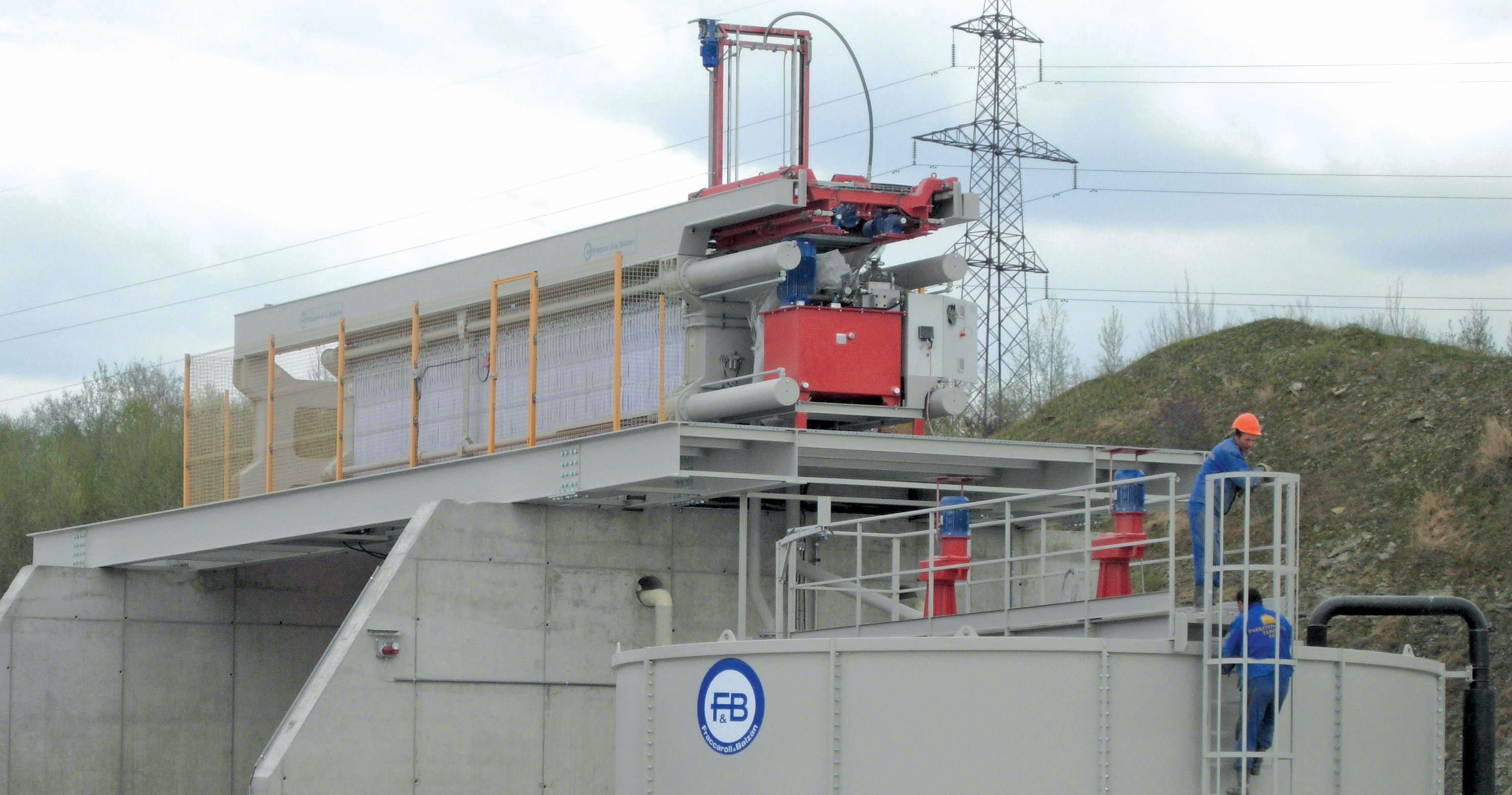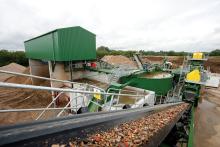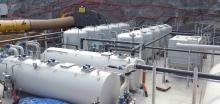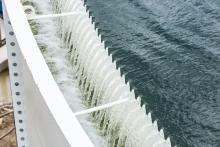
RSSIt is essential to adopt selective and economic techniques for purifying and recycling water. This is the view of Italian manufacturer Tecnoidea Impianti, which says that a gradual pollution of available water resources [for many reasons], and an increasing demand for it, make such actions necessary. Indeed, another Italian company, Fraccaroli e Balzan, has recently supplied a filter press to an Estonian company to complete a recycling process
A primary component of concrete, representing an average of 15% of the mixture, water is also used for cooling and preparing slurry for cement, washing aggregates, and cleaning plants and equipment, including concrete delivery trucks.
In the quarrying industry, water recycling is now an integral part of operations and is incorporated in sustainability programmes that often benefit not only the environment but also the wider community.
At the Draperstown Quarry, Northern Ireland, operated by Creagh Concrete, an upgrade to the existing washing plant released four million tonnes of material.
Carried out by the operator in conjunction with
Unlike other instances where the Aquacycle thickener has been specified, the driver was not an issue with water supply but rather an example of how environmental considerations are at the centre of the decision-making process for Creagh Concrete.
Meanwhile,
Established in 1969 it boasts thousands of plants installed and running worldwide, and in its search for new markets and new opportunities the company came into contact with Paekivitoodete Tehase.
A leading producer of construction materials in Estonia, the company is said to be the leader among crushed limestone producers in that country.
The high-grade crushed limestone is widely used as a filler material for asphalt and concrete products, and road building and infrastructure companies are among Paekivitoodete Tehase’s main customers.
Projects such as Tallinn Sea Port, Tallinn Airport, and the Tallinn-Narva and Tallinn-Tartu highways were built using crushed limestone from Paekivitoodete Tehase.
The material in the Paekivitoodete Tehase’s processing facility is washed and the waste water is treated using an existing water recycling plant: Fraccaroli e Balzan supplied the
The main design data show washed material is handled at 120tonnes/hour; fine material (less than 63 micron) averages 20% at 24tonnes/hour and the processing plant works an average of 16 hours.
After many visits to the Estonian quarry site, which included many filtration tests using samples of the customer’s material, Fraccaroli e Balzan decided a model FB/1500-120-4P Filter Press was required. It has 120 plates (each 1,500mm²) and the chambers are 25mm thick. The production rate is 5.45m³ each 30 minute cycle.
Slurry extracted from the existing decantation unit with a pump, is conveyed to a 150m3 homogenising steel tank also supplied by Fraccaroli e Balzan with two mixers to keep the slurry agitated.
A centrifugal double-body abrasive-resistant pump sends the slurry from the homogenising mud tank to the filter press.
The pump, manufactured and supplied by Fraccaroli e Balzan, features a 45kW motor controlled by electronic inverter and can achieve a pressure of 12bar.
The filter press is a newcomer in the production line of Fraccaroli e Balzan and offers the latest technological innovations in the filtration field. It is a four-piston filter press, complete with an automatic washing system for the clothes. The company has also introduced another new filter press with the code FB 2000.
“The filter press structure has two upper beams located laterally over its structure, leaving the top of the filter press completely open and this makes it possible to quickly remove the plates from the top for an easy maintenance,” says Fraccaroli e Balzan.
Also mounted on top of the machine are two shakers (a shaft with plastic cams, which rotates and hits the plate supports at the end of each filtration cycle in order to make sure that the dehydrated cakes fall down, no matter how sticky the mud is).
A mobile tray collects water dripping from the plates during the cycle and water from the automatic washing system, and also constitutes a walking platform.
The residual moisture in the dehydrated cakes, which can be achieved with this filter press, is less than 15%.
“The addition of the filter press from Fraccaroli e Balzan to the existing water recycling system allows Paekivitoodete Tehase to close its water cycle, thereby recovering completely all the waste material produced in its processing unit,” says Fraccaroli e Balzan.
“In fact, not only is the water recycled, but the dehydrated mud cakes discharged from the filter press will be used in the preparation of bricks and concrete. This means that now the processing plant of Paekivitoodete Tehase has virtually no waste at all.
“In this respect, the filter press from Fraccaroli e Balzan is of fundamental importance from an environmental point of view.”
At the inauguration of the machine, Estonia’s Deputy Secretary General of the Ministry of the Environment visited the plant, together with the Italian Ambassador in Estonia and other guests.
Tecnoidea Impianti, founded in 1981, says its technologies for water purification make it possible to reuse processed waste water as raw material. Over the past 32 years it has realised over 3,000 water purification and sludge treatment plants, used every day to recover more than 3.5 million m³ of water.
“This makes a remarkable contribution to saving water and energy resources, and therefore optimising the processing cycle of many companies,” says Tecnoidea (TECNOlogia Impianti DEpurazione Acqua).
The company is not alone in this, with other companies offering solutions to turn waste water into clean water using various methods.
Tecnoidea Impianti’s water and sludge treatment plant sees waste water discharged into the collecting pit ready to be conveyed to the vertical flow settling tank. This is followed by the flocculation process and subsequent separation of sludge and water with purified water overflowing from the upper part of the settling tank. There is a close cycle recovery of 95% and over.
Thickened sludge is discharged from the bottom part on the settling tank where the separation of solid-liquid is carried out through the filtering fabric.
“Clear water comes out of the filtering clothes of the filter press and dehydrated sludge comes out of the filter press and is perfectly shovelable,” says
Further explanation by the company shows that the collecting pit collects waste waters arriving from the aggregates washing plant, and via a lifting pump these are conveyed to the static settling tank.
“The flocculation unit consists of an automatic plant that is able to prepare a flocculating mixture from powders that is properly related to a water volume in order to get an optimal concentration and dose it through the batching pumps in the pipe which conveys the waste water to the settling tank. This starts the flocculation process,” says Tecnoidea Impianti.
In the vertical flow settling tank liquids and solids are separated forming sludge flocs which, gaining weight and volume, separate from the water and fall towards the conic part of the tank, making it possible for the clean water to rise to the upper part of the tank. The purified water storage tank collects the purified water and this overflows from the settling tank.
“The reusing of the water in the cycle can happen, taking advantage of the hydraulic head resulting from the height of the piezometric tank or by means of a booster pump,” says Tecnoidea Impianti.
The sludge tank under the settling tank collects the thickened sludge which is kept liquid and homogeneous through a mixer, allowing for a constant density at the filter press feeding pump suction. A sludge pump is needed to transfer the liquid and homogeneous sludge from the sludge pit to the filter press, which has chambered plates and is essential to dehydrate the liquid sludge.
“There are two types of filter presses: traditional and the new conception ones.
“The first are used to dehydrate small volumes of sludge with standard filtering pressures while the second are used to dehydrate medium and large volumes of sludge with filtering pressures up to 1.6MPa.”
According to Tecnoidea Impianti, apart from clear water, the dehydrated sludge are increasingly classified as non-dangerous inerts and as by-products perfectly suitable to be recovered for the remediation of escarpments and sides of quarries; brick production; reinforcement of the pipes of technological plants; in the ceramic industry; for the improvement of the agricultural soil, and as binder for the industry; and as sub-base for roads.
Tecnoidea Impianti says it now offers soil washing plants, a new range of high beam filter presses and a new dynamic system for measuring the sludge level inside the settling tank.
The processing of polluted materials, such as soils and demolition material, AIMS to eliminate contaminants so that the obtained sands and gravels can be used for industrial and residential uses, while the polluting substances are conveyed in the waste water, which is again treated to separate water and sludge.RSS










